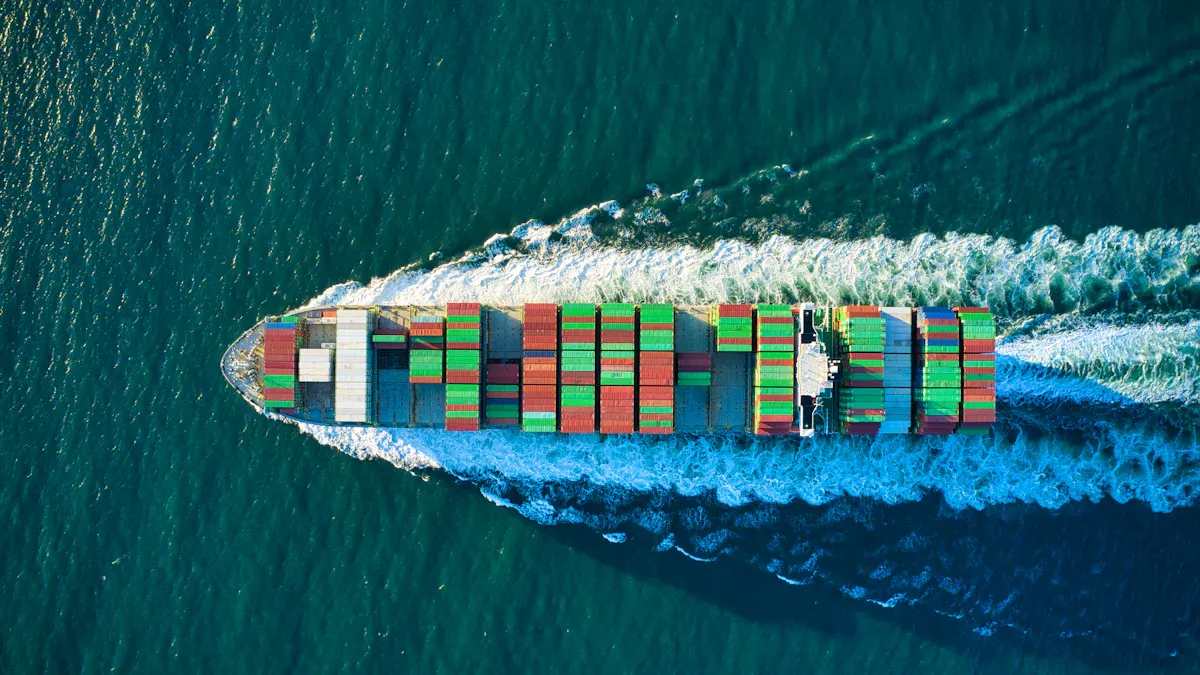Understanding Maritime Freight and Its Role in Global Trade

Maritime freight is key to global trade. It moves over 80% of goods traded worldwide. For many poorer countries, this number is even higher. Ships carry 70% of trade in containers. Each container was worth about $54,000 in 2020. This system links countries, boosts business, and supports supply chains everywhere.
Key Takeaways
Ships carry over 80% of goods worldwide, making them vital for trade. Knowing this helps you see how items get to you.
New tech like IoT and blockchain makes shipping safer and faster. Using these tools can make supply chains work better.
Eco-friendly shipping helps nature and improves your company’s reputation. Green practices can bring in more buyers.
The Role of Maritime Freight in Global Trade
What is Maritime Freight and Why It Matters
Maritime freight means moving goods across oceans using ships. It is very important for connecting countries and keeping trade running smoothly. You depend on maritime freight more than you think. It helps with the systems that make global trade work. Without it, supply chains would break, causing shortages of important items, like during the COVID-19 pandemic.
Here’s why maritime freight is important:
About 90% of world trade uses ships.
Over 50,000 cargo ships deliver goods worldwide.
The shipping industry gives jobs to over 1.5 million people.
Since ancient times, ships have helped economies grow and improved with new technology.
Maritime freight is not just about shipping goods. It connects people, businesses, and countries. It makes sure you can get products from all over the world, helping economies grow and nations work together.
Key Statistics Highlighting Its Impact
The numbers show how much maritime freight helps global trade. You might not realize how much the world depends on it.
In 2015, ports unloaded about 9.96 billion tons of goods, says UNCTAD.
Mining and Quarrying industries use ships for 75.7% of trade value and 86.0% of weight.
Poorer countries and small islands rely on ports 1.5 to 2 times more than others.
The top five ports handle goods equal to over 1.4% of the world’s economy.
These facts show how important maritime freight is for moving goods and keeping supply chains strong.
How JUSDA Supports Global Trade Through Maritime Freight
JUSDA helps global trade by offering smart shipping solutions made for your needs. With over 155 service points and 2.5 million square meters of warehouse space, JUSDA makes logistics easy.
Here’s how JUSDA helps with maritime freight:
Comprehensive Services: JUSDA offers shipping options that save money and time. They include combining shipments, distribution, and trade platforms.
Advanced Technology: JusLink uses IoT, cloud computing, and big data to give you real-time updates and control over your supply chain.
Industry-Specific Solutions: JUSDA works with industries like electronics, cars, and FMCG to create custom logistics plans.
Global Reach: With warehouses in places like China, Vietnam, and the U.S., JUSDA supports trade by managing stock and improving operations.
JUSDA’s focus on new ideas and efficiency makes it a reliable partner in shipping. Using advanced technology and a strong global network, JUSDA ensures your goods arrive safely and on time.
Key Parts of the Maritime Freight System
Types of Shipping Vessels
Ships are the main part of maritime freight. Different ships carry different goods across oceans. Container ships move products like clothes and electronics. Bulk carriers transport raw items like coal and grain. Tankers carry liquids such as oil and chemicals. RoRo ships are used for vehicles, while general cargo ships handle smaller loads.
Ships come in many sizes. Huge container ships can hold over 20,000 TEUs (twenty-foot equivalent units). These ships are very important for global trade. Special ships, like LNG carriers, safely move delicate goods. Using the right ship helps save money and protect the environment.
Ports: Key to Global Trade
Ports are very important for shipping. They are places where goods are loaded and unloaded. Good ports help move goods faster and avoid delays. The top 10 ports handle over half of the world’s container traffic, showing their big role in trade.
Ports are judged by how well they work. For example, ships spend about 2.6 days at ports to load and unload. Port services cost 10-20% of total shipping expenses. Real-time data helps businesses make better choices and avoid delays. Automated systems, like robot container handlers, make ports even more efficient.
Fact | Number |
|---|---|
Goods traded globally (2022) | |
Top 10 ports' share of container traffic (2021) | Over 50% |
Average time for ship at port | 2.6 days |
Port service costs as part of shipping costs | 10-20% |
Warehousing in Maritime Freight
Warehouses are important for storing goods before and after shipping. Modern warehouses use smart systems to track items, like JUSDA’s JusLink platform. This technology shows where goods are in real time, making things easier to manage.
Warehouses also do extra jobs like packing and labeling. These tasks make the supply chain faster and cheaper. For example, JUSDA’s warehouses in Vietnam have clean rooms and bonded storage for industries like electronics and cars. By connecting warehouses with ports and shipping, businesses can deliver goods faster and more smoothly.
Challenges and Opportunities in Maritime Freight
Environmental Sustainability and Green Shipping
Environmental issues are changing how maritime freight works. Shipping helps global trade but harms the environment. Ships release gases that cause climate change. The International Maritime Organization (IMO) wants to cut these gases by 50% by 2050. This pushes the industry to use greener methods.
Green shipping uses cleaner fuels like LNG, methanol, and hydrogen. These fuels create less pollution. New ship designs and slower speeds also save fuel. Ports are using renewable energy and electric systems to be more eco-friendly.
But these changes are costly. Small companies may struggle to afford them. Still, green shipping offers benefits. Companies using eco-friendly methods can attract more customers and stand out.
🌱 Tip: Going green helps the planet and improves your brand image.
Security and Risk Management in Global Trade
Security is very important in maritime freight. Safe routes ensure goods arrive without problems. But risks like piracy, theft, and conflicts can cause delays. For example, wars in places like Ukraine disrupt shipping and raise costs.
Risk management is improving worldwide. By 2023, 63.7% of global risk measures were in place. The UN ranks risk management as a top priority for trade.
Technology helps make shipping safer. Blockchain prevents fraud, and tracking systems reduce theft. Governments and companies working together also improve security.
Key Security Challenges:
Piracy and stolen goods
Conflicts affecting shipping routes
Cyberattacks on digital systems
Opportunities in Risk Management:
Better tracking tools
Blockchain for safer deals
Global teamwork to solve problems
Addressing Labor and Workforce Challenges
The shipping industry has big workforce problems. Skilled workers are needed, but there aren’t enough. Hiring costs are rising because of inflation and demand.
Older workers retiring create leadership gaps. Training schools now teach skills like cybersecurity and AI navigation. These programs prepare workers for new technology.
Mental health is another issue. Long trips and being away from family cause stress. This leads to workers quitting. Solving these problems means investing in training and mental health support.
Key Workforce Challenges:
Fewer skilled workers and aging staff
Opportunities for Improvement:
More training for new technologies
Better mental health programs
Attracting young workers with career growth plans
🚢 Note: Supporting workers ensures smoother shipping and future success.
Innovations Shaping the Future of Maritime Freight
Digitalization and Smart Supply Chains
Digital tools are making maritime freight smarter and faster. You can now track shipments live, plan better routes, and save money. Technologies like IoT and blockchain make shipping safer and more open.
Automation and Autonomous Ships: These ships use AI to work with little human help. They lower costs and make shipping safer.
Smart Containers: Special containers with IoT check cargo conditions to keep goods safe.
Digital Twins: Virtual models of ships and ports help find problems early and improve work.
Metric | Description |
|---|---|
Software helps crews manage tasks and ship upkeep. | |
Quick Decisions | Live data helps change routes and save fuel. |
Eco-friendly Practices | Tracking emissions supports greener shipping. |
Improved Supply Chains | Clearer tracking boosts teamwork and customer happiness. |
These new tools make shipping quicker, safer, and more dependable.
🚢 Note: Using digital tools keeps your supply chain strong in a tough market.
Sustainability Efforts in Maritime Logistics
Shipping is going green to protect the environment. Cleaner fuels like LNG and hydrogen are replacing older, dirtier ones. Ships using wind power and hybrid engines are cutting pollution.
Governments and groups have set big goals:
Carbon Intensity Reduction Targets: Cut emissions by 11% by 2026, 40% by 2030, and 70% by 2050.
Emission Controlled Areas (ECAs): Stricter rules in certain zones to lower pollution.
Energy Efficiency Existing Ship Index (EEXI): Rates how energy-efficient ships are.
Metric | Description |
|---|---|
Economic Performance | Checks how well logistics work in different countries. |
Energy Efficiency | Measures how much energy is used for work done. |
Infrastructure Strength | Looks at how reliable shipping systems are. |
Innovation in Green Practices | Tracks new ideas for eco-friendly shipping. |
Green shipping helps the planet and makes your brand look better.
🌱 Tip: Going green can attract customers who care about the environment.
Evolving Trade Patterns and Regional Shifts
Trade routes are changing because of tariffs and demand shifts. New paths are opening as countries adjust to these changes.
Shipping companies are changing routes to avoid tariffs.
More blank sailings are happening on Asia–US and Europe routes.
US Gulf trade is moving from China to India and Indonesia.
These shifts show why flexibility in shipping is important. Experts predict transport demand will grow 40% by 2035, mostly from regional trade.
🌍 Alert: Knowing about trade changes helps you adjust and find new chances.

JUSDA Solutions
To provide you with professional solutions and quotations.
Maritime freight is crucial for global trade and economies. It helps people get goods, keeps supply chains working, and grows businesses. Building better ports and logistics systems creates jobs and increases trade earnings.
Evidence Description | Key Findings |
|---|---|
Shipping and trade in Africa | Lower transport costs improve trade and connect countries. |
Ports and logistics upgrades | Better ports grow trade and help economies thrive. |
UNCTAD trade report | Shipping is key for trade and economic progress. |
JUSDA’s smart logistics make shipping easier and more dependable. Using new technology and teamwork, we can solve problems and build a greener future for shipping.
See Also
Exploring Innovations in Sea Freight Logistics for 2024
A Detailed Look at the Future of LTL Freight
How Supply Chain Visibility Drives Success in E-commerce
Discovering Key Insights About Global Logistics Companies
Understanding the Importance of Supply Chains in Global Trade
